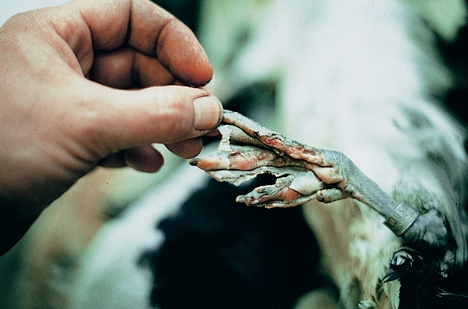Difference between revisions of "Avian Medicine Q&A 22"
Jump to navigation
Jump to search
| Line 10: | Line 10: | ||
'''This picture shows a duck's foot.''' | '''This picture shows a duck's foot.''' | ||
<br> | <br> | ||
| − | <FlashCard questions=" | + | <FlashCard questions="5"> |
|q1= Describe the lesions shown above. | |q1= Describe the lesions shown above. | ||
|a1= Dry gangrene and loss of tissue from the extremity of a duck’s foot. | |a1= Dry gangrene and loss of tissue from the extremity of a duck’s foot. | ||
| − | |l1= | + | |l1=Low Temperature Damage |
|q2= What are the possible aetiologies? | |q2= What are the possible aetiologies? | ||
|a2= Dry gangrene of extremities, as seen in mammals, has not been recorded in birds. This is caused by frostbite. Ergot poisoning has not been reported in birds. | |a2= Dry gangrene of extremities, as seen in mammals, has not been recorded in birds. This is caused by frostbite. Ergot poisoning has not been reported in birds. | ||
| − | |l2= | + | |l2=Low Temperature Damage |
|q3= Which species are most commonly affected? | |q3= Which species are most commonly affected? | ||
|a3= Waterfowl are most commonly affected by frostbite in this manner. Waterfowl lose heat by panting or heat exchange through their legs. However, most waterfowl are remarkably tolerant of frost effects, particularly if they have open water to swim in. When sedentary, they tend to squat down, sitting on their feet in order to maintain temperature. Species endogenous to warm climates, but kept in temperate areas, are most susceptible. | |a3= Waterfowl are most commonly affected by frostbite in this manner. Waterfowl lose heat by panting or heat exchange through their legs. However, most waterfowl are remarkably tolerant of frost effects, particularly if they have open water to swim in. When sedentary, they tend to squat down, sitting on their feet in order to maintain temperature. Species endogenous to warm climates, but kept in temperate areas, are most susceptible. | ||
| − | |l3= | + | |l3=Low Temperature Damage |
|q4= What undesirable side effect may be seen as a consequence of a bird’s attempt to avoid the condition? | |q4= What undesirable side effect may be seen as a consequence of a bird’s attempt to avoid the condition? | ||
|a4= Flamingos and other long-legged birds, being unable to sit on their feet to maintain heat, simply reduce peripheral circulation. Although they often avoid frostbite, the long-term effect of poor pedal circulation is a marked deterioration in dermal quality, leading to cracking and low-grade bacterial infections. | |a4= Flamingos and other long-legged birds, being unable to sit on their feet to maintain heat, simply reduce peripheral circulation. Although they often avoid frostbite, the long-term effect of poor pedal circulation is a marked deterioration in dermal quality, leading to cracking and low-grade bacterial infections. | ||
| − | |l4= | + | |l4=Low Temperature Damage |
|q5=How can the condition be avoided? | |q5=How can the condition be avoided? | ||
|a5= The condition is avoided by either not keeping warm climate birds in cold areas, or by keeping them inside during extreme weather. Even in such circumstances, water temperature may have to be artificially raised although water hygiene can be a problem if large numbers are housed together inside. | |a5= The condition is avoided by either not keeping warm climate birds in cold areas, or by keeping them inside during extreme weather. Even in such circumstances, water temperature may have to be artificially raised although water hygiene can be a problem if large numbers are housed together inside. | ||
| − | |l5= | + | |l5=Low Temperature Damage |
</FlashCard> | </FlashCard> | ||
Latest revision as of 23:43, 21 August 2011
| This question was provided by Manson Publishing as part of the OVAL Project. See more Avian Medicine questions |
This picture shows a duck's foot.
| Question | Answer | Article | |
| Describe the lesions shown above. | Dry gangrene and loss of tissue from the extremity of a duck’s foot.
|
Link to Article | |
| What are the possible aetiologies? | Dry gangrene of extremities, as seen in mammals, has not been recorded in birds. This is caused by frostbite. Ergot poisoning has not been reported in birds.
|
Link to Article | |
| Which species are most commonly affected? | Waterfowl are most commonly affected by frostbite in this manner. Waterfowl lose heat by panting or heat exchange through their legs. However, most waterfowl are remarkably tolerant of frost effects, particularly if they have open water to swim in. When sedentary, they tend to squat down, sitting on their feet in order to maintain temperature. Species endogenous to warm climates, but kept in temperate areas, are most susceptible.
|
Link to Article | |
| What undesirable side effect may be seen as a consequence of a bird’s attempt to avoid the condition? | Flamingos and other long-legged birds, being unable to sit on their feet to maintain heat, simply reduce peripheral circulation. Although they often avoid frostbite, the long-term effect of poor pedal circulation is a marked deterioration in dermal quality, leading to cracking and low-grade bacterial infections.
|
Link to Article | |
| How can the condition be avoided? | The condition is avoided by either not keeping warm climate birds in cold areas, or by keeping them inside during extreme weather. Even in such circumstances, water temperature may have to be artificially raised although water hygiene can be a problem if large numbers are housed together inside.
|
Link to Article | |
